

Swans Down Assures White Thanksgiving
As November 11 came and went, Bruce Bauer waited, disappointed. "November 11 is tundra swan day to me and some of the other watchers around the thousands of miles of Chesapeake shore," noted New Bay Times’ official swan announcer.
Bauer’s disappointment lifted on the morning of November 12 as the
first pair sailed into Masons Beach from the northern extremes of Alaska
and Canada’s Northwest Territories. "There are always a couple
of scouts. They seem to do things in pairs," Bauer said.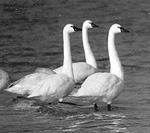
"They wiffled down," he wrote a couple years back, describing the annual event, "spilling air from their wings by rocking from side to side amidst raucous whoopings.
"Once down low in a landing pattern, they straightened out into the wind, boring in like heavy seaplanes or — better — like the space shuttle on touchdown at a high angle of attack. At the last minute, their shiny black Ping-Pong-paddle-size feet cocked up to breaking position. Then the splashy touchdown."
Around and about Chesapeake Country, Bauer’s sighting has been confirmed. The big birds — fully grown, they weigh in at about 30 pounds with a six-foot wingspan — are still scarce in sky and shallows. More are coming. Last year, Bauer counted flocks of 150 feeding on grasses in the shallows.
More will come if you offer corn.
-NBT
Lend a Helping Hand: Your Guide to Volunteering
Wondering what to do with your idle hours this holiday
season? Need a break from the relatives? Or a way to ward off the winter
blahs?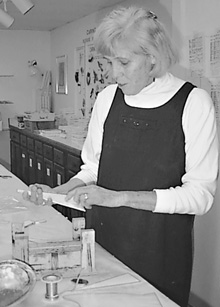
Try volunteering a few hours for one of Chesapeake country’s many worthy causes. There’s plenty of need for helping hands, even in this time of unprecedented bounty. With a cornucopia of causes to choose from, you’ll find something you like. And the satisfaction, experienced volunteers say, returns far more than you give.
If your plate’s ready for a helping of helping out, here’s your guide to what, where, when, how and for whom:
With Thanksgiving almost here and Christmas not far behind, local charities and community organizations are gearing up for their busy season. Now’s the best time to get into the busy bliss of giving.
In the Annapolis area, help Larry Griffin’s We Care & Friends gather donations for Thanksgiving Dinner or help serve up the feast at the Annapolis American Legion on Monday, November 23. Information? 410/295-5223.
To help make a moveable feast, try these two basket drives that collect donations and deliver complete Thanksgiving dinners to needy families and individuals: Grace Evangelical Presbyterian Church in Edgewater; and the Basket Brigade in Annapolis. Call Gloria Maheffey at the church: 410/956-2083. Or Basket Brigade: 800/991-8571.
If you’re feeling artistic, The Caring Collection of Annapolis can use your help creating stained glass angels and suncatchers for the fight against cancer. No experience? No problem, they’ll show you how it’s done. They need help with non-production tasks, too. Call Bobbie Burnett: 410/849-5333.
Other feats of festive philanthropy:
Perhaps you can offer your wisdom, insight and caring to others.
If life’s been good to you this year, give a little back. If you’ve had better, give anyway — for those who have it worse. We won’t say give until it hurts, because, as all Chesapeake Country’s volunteers know, giving never does.
-Don Kehne
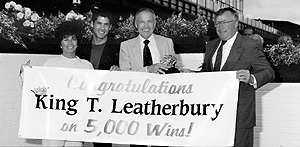
"The Dream With a Rhyme"
First you bet your last dime
Then await post time--
The starting gate bell with a chime.
And it is a race to the finish line.
After they light the official sign,
You float to the cashier’s line
Ah, it sure will be fine in 1969.
-King Leatherbury, Christmas 1969
With a 7:30pm post time, many of the standing-room-only crowd arrived early, jockeying for seats when Shady Side native King Leatherbury held recent court at the Captain Salem Avery Museum in Shady Side.
Leatherbury, Maryland’s leading thoroughbred trainer, is one of only three trainers in the history of racing to top 5,000 wins: he boasts 5,750 wins. He won his first Maryland training title in 1971 and has been on top ever since.
Ask King Leatherbury how you learn to train horses and he’ll say you have to work your way up in the ranks, work with other trainers, get around in the business, get the experience. Then he’ll tell you that’s the thing he didn’t do.
Leatherbury claims he learned to train horses by studying racing forms during his stint in the Army in Alabama in the late 1950s. From Maryland tracks, his uncle sent "something you can’t get in books": the racing forms, daily papers full of inside articles and statistics on horses and trainers and jockeys.
The trainer-in-training poured over the information, keeping a scrapbook on the details of racing. When he came out of the Army, he headed straight into training.
Training a horse is not like training a circus animal, Leatherbury explained. "Training a horse is more like managing an athlete, like a prize fighter, keeping him healthy and matching him with an opponent he can beat."
Of course, Leatherbury had another advantage in the trade. He’d been around horses all his life. His father, Taylor, owned and bred horses on what has since become Leatherbury’s 192-acre farm along Route 468 in Southern Anne Arundel County.
Running the farm to breed and raise horses, as his father did, is a losing proposition, Leatherbury said. The odds of success may be worse than in gambling.
Which is another subject on which King Leatherbury was right on the money.
"In racing, you get a run for your money," said he. "What appeals to the gambler is that you’re involved in the outcome. You can handicap a race anyway you see it — by bloodlines or previous record, by the jockey or trainer, and you have a personal interest in the outcome. That’s the fun of the game."
That game, thoroughbred horse racing, means big stakes for Maryland, where, Leatherbury says "the history goes back 250, some say 300 years." Thoroughbred racing is the largest industry in our state, employing 17,000 people, contributing a billion dollars a year to the state economy.
Each Maryland taxpayer supports the horse racing industry. A few years back, the governor and general assembly began giving Maryland’s racing industry $10 million a year.
"A payoff from the state," Leatherbury called it, "rather than letting in slot machines."
Leatherbury wants the slots Gov. Parris Glendening opposes. The tracks are a controlled place already set up for gambling, with no children, Leatherbury argued.
What’s more, Maryland racetracks need the revenues. "We need slot machine revenue to boost the purses, or winnings, of horses," he said.
Every betting dollar contributes about six cents to racing purses. The average purse at Laurel is about $15,000.
Andrew Beyer, who writes a racing column for the Washington Post, projected that with slots, the purse for ‘maidens’ — horses still to win a race — could grow to $80,000.
Like maidens and purses and racing forms, the claiming race is part of the risky world of racing. In each such race, the daily racing form lists a claiming price for the runners. You offer the price, and the owner must sell.
"That’s my kind of game," said the trainer of 40 years. "The most economical way of buying horses is by claiming them."
Columnist Beyer noted that means "Leatherbury lives by his wits. He’s owned more horses by claiming than anybody in the game, ever."
On the other hand, Leatherbury countered, "If someone wants to sell you a horse, don’t buy it; there must be something wrong."
How about favorites?
"My current winner is my favorite horse," Leatherbury quipped.
-M.L. Faunce
Fowler's Mark: Science Center
Shares His Name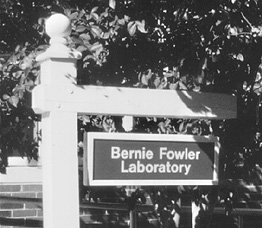
"To make sure I got something named after me, I made my son a junior," joked an appreciative Bernie Fowler at a special ceremony last November 12.
Now his name has found still another home. Congratulations Bernie — it’s a building.
The Chesapeake Biological Laboratory in Solomons has renamed its state-of-the-art
Coastal Chemistry Laboratory the C. Bernard Fowler Laboratory. That’s
the Bernie Fowler Lab for short.
"It was pretty clear to us who it was going to be named for as soon as we built it," said Donald Boesch, president of the University of Maryland Center for Environmental Science, of the four-year-old building. "The delay was because of University of Maryland’s rule that you can’t name a building after a politician within three years of his retirement."
Anyone who’s lived here long needn’t ask why Fowler is that politician. His regionally famous wade-ins are known the world over by conservationists. Boesch recalled a meeting with international colleagues at a coastal conservation conference in Stockholm. "When we told them we were from the Chesapeake they replied, ‘isn’t that where the guy goes out and wades in the water?’"
It’s not just the world-famous soggy sneakers that earned the honor. Bernie Fowler did, after all, lead the crusade to save the Bay and promote conservation. The campus was a crucial partner, lending its data for ammunition.
But the shoes did come up often as a hail of accolades befell Fowler. "I was thinking we ought to bronze those and put them up there," joked Walter Boynton, a friend and senior professor at the campus.
And a fitting decoration they’d be, as those sneakers have become an icon of Fowler’s environmental example. "Bernie was doing it before it was popular," said Boynton of Fowler’s trailblazing green streak — for which Boynton and others offered sincere thanks.
State senate president Mike Miller and U.S. Sen. Paul Sarbanes were among the many to step up to the podium and run down Fowler’s legacy. A cascade of kind words poured from all as heartfelt praise was expressed by a series of friends and colleagues. The tribute so touched Fowler that he needed a moment to collect himself after getting choked up during his speech.
"That’s the first time it’s happened to me in 30 years," said Fowler, reflecting on the second time he became a senior.
-Mark Burns
Waiting for van Gogh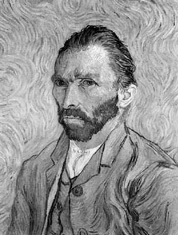
People handle standing in lines in a hundred different
ways. More, actually, when the line leads to Vincent van Gogh. Figure a
different way for each person standing in a line snaking two-thirds of the
way around the square-block West Wing of Washington’s National Gallery
of Art, waiting for up to four free same-day tickets for the otherwise sold-out
show.
Standing in line is an art form in itself as for the sake of art, sell-out crowds queue up day after day. Some read books or newspapers. Some stare fixedly, as if in meditation. Some wait for friends to relieve them, turning up with coffee. Some lounge in sleeping bags; others sit in folding chairs. Some take a short walk to a refreshment truck. The entrepreneurial vendors are cleaning up.
So are the homeless, many of whom seem to have made the van Gogh line part of their daily routine. Later in the morning, they’ll turn patience into money, giving late-sleepers their chance to see van Gogh.
As the time stretches, companions share stories of summer travels (Zaire, London. These are a well-traveled lot, used to queuing up for trams and trains and such). Strangers become friends.
The first in a recent weekend’s line arrived at 3am. These teenagers, the envy of even those so far back they cannot see them, have standing. A flank and a half of the building behind them, a trio of matrons have stood since 6:30am. They are proud of their achievement. They’ll see van Gogh sometime today.
Others will not. By 9:30, the line stretches far beyond the point (about half way around the enormous building) where a scooter bears a sign warning all beyond here that they’re likely to be out of luck.
Standing in line is a pilgrimage of sorts, time spent preparing for a passage from the ordinary to the sublime. Art lovers, fanatic sports fans, rock concert-goers. We’re all alike when it comes to pursuing our passion. For this group, it’s waiting for van Gogh.
In this lingeringly warm weather, you could find worse ways to spend a morning.
-MLF/SOM
In California, hard-core bikers are crying in their beers. Why? The Lighthouse Pub in Avila Beach, a Hell’s Angels favorite, has closed for good. The bar and every structure in town is being demolished as part of a massive pollution clean-up by Unocal, the oil company. One biker was even moved to poetry, according to the Los Angeles Times. On the wall he wrote: "We sat in here and drank our beer and hung out with our friends. Unocal’s tearing down our beautiful town but the party never ends"…
China is known as a major polluter but recently, the Chinese sent an ice-breaking ship to Antarctica to remove debris left behind during 14 years of research at its Great Wall base, reports Inside China Today. The ship will haul back everything that can’t be burned …
Our Creature Feature comes to us from underwater, where studies are showing that fish make good moms and pops. Researcher Ronald Coleman was quoted in the Sacramento Bee last week as saying that he’s been learning that the parental instinct in fish is strong.
He says he has found fish families with single moms, single dads and parents that "baby-sit jointly." Coleman said that in the world of fins and scales, he’s detected lessons about parenting "for his own species to live by."